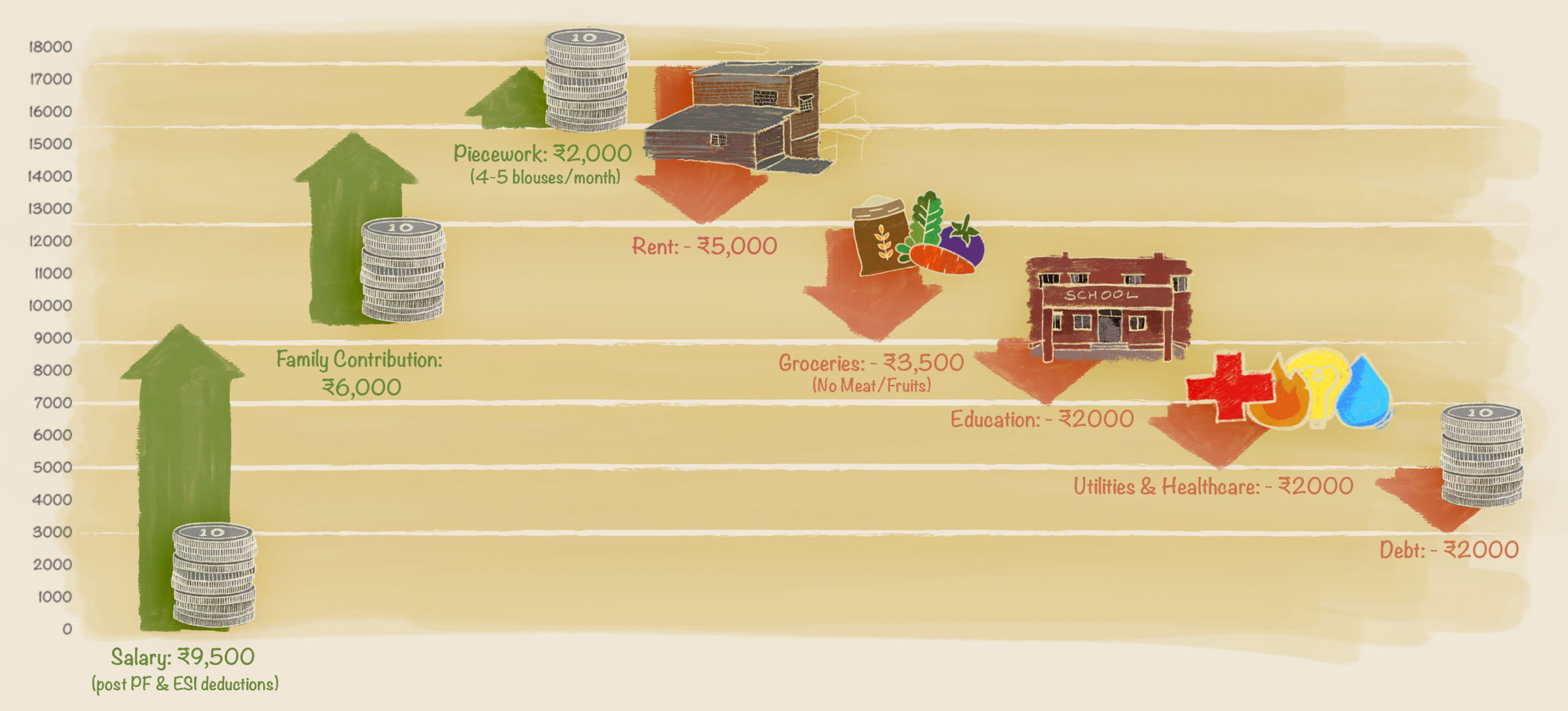Workers’ Voice
Workers’ Voice brings you the true stories of garment workers, highlighting the challenges they face every day. Through reports and infographics, we showcase their struggles with wages, working conditions, discrimination, and other human rights risks within global supply chains. Explore the realities of their lives and share their stories.

Wage Sufficiency
Wage sufficiency means earning enough to meet essential needs like food, clothing, housing, and medical care, while also ensuring security against unemployment and unexpected expenses. A Cividep report reveals that only 1% of garment workers earn even half of what’s considered a living wage, with just 3% making more than the industry minimum. This illustrates the gap between gross and living wages in cities like Bengaluru. Nearly 58% of workers in Cividep’s latest report (Home & The World of Work) identified higher wages as their top priority, citing inadequate earnings that force them into overtime or additional jobs. Take a look at the infographic below to understand the challenges faced by many garment workers just to get by.
The True Cost of Low Wages
Garment worker Sheela’s monthly challenges involve juggling multiple jobs and cutting back on essential expenses like nutritious food and medical care. To make ends meet, she often skips meat and fruits, walks instead of taking the bus, and goes without hygiene products or medicines. She saves ₹500 by avoiding doctor consultations and another ₹500 by forgoing entertainment and outings. Her efforts reveal the reality of financial instability and inadequate healthcare, impacting both her and her children’s future.
Worker Story
Have You Seen This Harried Woman Who Races Past Busy Traffic Signals Off Mysuru Road? Meet Sheela, A Tailor at A Big Garment Factory, Whose Low Pay Doesn’t Leave Much For Having Healthy Meals or Comfortable Work Commutes
It’s The Long Way Home Everyday For Sheela
By Sandhya Soman & Sharmada Kaushik
Till recently, Sheela (name changed) would zip through the bylanes of Jawaregowdana Doddi on foot to reach her office on the busy Mysuru Road. With its glass and concrete façade, the garment factory could be mistaken for an IT company, another Bengaluru staple that attracts young talent nationwide.
However, the comparison ends there. Despite recent layoffs, the typical software job still offers competitive salaries and perks, a far cry from Manju’s monthly earnings of Rs. 10,500 – barely half of what’s considered a decent living wage. Her daily hour-long morning walk has nothing to do with fitness but all to ensure that she punches in on time at the factory without ‘wasting’ a single rupee on bus fare. In the evening, after an exhausting 8-hour tailoring shift, the 35-year-old single parent retraces her steps home to her mother and son.
“Susth aadru maadbekalla (Don’t I still have to do it even if I’m tired?),” asks Sheela matter-of-factly. She now occasionally takes the bus to work, thanks to the Karnataka government’s free travel scheme for women. Her composure slips when discussing her son. “Sometimes I think I could have provided him with a better education if I earned more,” she says, her eyes welling up with emotion.
Money Matters
Her meager wage is at the heart of Sheela’s struggle despite years in the industry. Starting with Rs. 5,500 in 2010, her monthly income now is a mere Rs. 9,500 post-deductions. Meanwhile, her monthly expenses have soared to Rs. 11,500 (see graphic). Her mother, earning Rs. 6,000 as a housekeeper, can only contribute minimally to the household finances.
Sheela’s plight is not unique. India’s garment manufacturing industry, with an annual turnover of thousands of crores, employs millions of workers, with a significant majority being women. In Bengaluru alone, over 1,500 units employ nearly 5 lakh women, many earning below Rs. 10,000, as per the latest Cividep report (link).
The prevalence of low wages among workers, particularly affecting women and migrants, is largely attributed to the dominance* (link) of major global brands wielding considerable monopoly power. These brands engage numerous Indian suppliers to gain a competitive edge, forcing suppliers into cut-throat competition. They, in turn, pass the burden onto their workforce through high workload demands and low wages.
The state’s long-overdue initiative towards adopting a living wage by 2025 signifies a crucial step towards rectifying this disparity and moving towards a more sustainable labour environment.
A Frugal Strategy
For now, the consequence is wages that fall far short of what’s necessary for a decent standard of living, as defined by the ILO. Sheela’s family diet lacks meat or fruits, relying solely on basic provisions from the state’s public distribution system. Their modest one-bedroom dwelling in Rajarajeswari Nagar sees few indulgences, with eating out and gift-giving reserved for special occasions.
Sheela often works overtime to supplement her income, earning extra to cover rent, school fees, and groceries. However, unexpected medical emergencies wreak havoc on her budget, compelling her to seek additional income through tailoring work for neighbours – 4-5 sari blouses to make Rs. 2,000 more.
Family Debts
Sheela’s family background is similar to several garment workers, who are first-generation factory employees (report link). In 2003, at age 15, Sheela dropped out of school due to financial pressures and moved from rural Mandya to Bengaluru with her family. Her father and elder brother worked as a security guard and a driver, respectively. Upon marriage at 17, Sheela faced financial constraints as her husband controlled her income. “He (husband) used to control what I did and didn’t give much money. He also drank a lot,” recalls Sheela.
Four years later, his death left her with the responsibility of raising their son and repaying loans for her father’s medical bills and her husband’s dialysis treatment. Sheela took up a garment factory job, but it took her five years and briefly working for the creditors to repay most of the debts. Sheela has been back at her factory job for the past two years. Her mother continues to repay a Rs. 4 lakh loan for her father’s medical expenses.
Emotional Toll
Life is far from steady as every month there would be some emergency. The stress levels are so high that the mother keeps a close watch on her daughter. “Nam ammange bhaya (my mother is scared),” she says. So much so that Manju has no social interaction apart from routine transactional conversations with colleagues and neighbours. Conversations about her personal life, especially her dreams for her son, overwhelm her at multiple points, possibly pointing to the need for an emotional outlet.
In Cividep’s latest report, nearly 58% of garment workers surveyed said higher wages were their top priority. The reason? Insufficient earnings, cited by 88% of respondents. To make ends meet, 82% of workers resorted to overtime, while 16% took on additional jobs, spending an extra two hours a day working outside the factory. (*link). This highlights the urgent need for living wages.
ILO notes that millions of workers worldwide cannot afford healthy food, decent housing, medical care, or schooling for their children due to low wages. In this context, the Indian government’s plan to introduce living wages by 2025 is crucial to improving workers’ livelihoods.
Sheela has no option but to be frugal. On some days, exhaustion kicks in, and she pauses. Then she remembers her son’s dream to join the police force. “Nam jeewna hengo nadidhoythu; aadre nam maga vodli antha ashte kashta padtairadu (My life will run somehow but I’m working hard so that my son doesn’t have to live like me).” She hopes to save more for his future.. “Maybe, I will save some money this month and I can put him in a better school,” she says, breaking into a rare smile.


